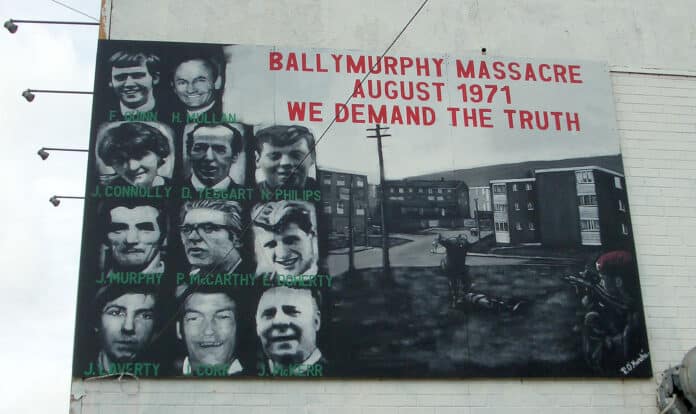Ten people shot dead at Ballymurphy, west Belfast, in 1971 were innocent and their deaths were without justification, a coroner has ruled.
Relatives of the nine men and one woman who were killed applauded when Mrs Justice Keegan exonerated them and found there had been a disproportionate use of force.
The coroner attributed nine of the 10 shootings to the British Army.
She ruled out any paramilitary involvement by any of those killed, and described them as “entirely innocent of any wrongdoing on the day in question”.
Mrs Justice Keegan said the shootings had been a violation of Article 2 of the European Convention on Human Rights – the right to life protected by law.
Following the ruling, Northern Ireland’s Deputy First Minister Michelle O’Neill described the killings as “British state murder”.
“The victims and the families of the Ballymurphy Massacre have been vindicated and the truth laid bare,” she tweeted.
The fresh inquests did not include an eleventh person, Paddy McCarthy, who was shot in the hand at a community centre and later died of a heart attack.
The dead included a Roman Catholic priest, Father Hugh Mullan, 38, and Francis Quinn, 44 who was shot when he went to the churchman’s aid.
Four people died in the second incident – Noel Phillips, 19; Joan Connolly, a 44-year-old mother of eight children; Daniel Teggart, 44, and Joseph Murray, 41.
Edward Doherty, 43, John Laverty, 20, and Joseph Corr, 43 were the last three victims of what residents of the community call “the Ballymurphy massacre”.
The shootings occurred over three days in August 1971 during serious civil unrest in Belfast when the government moved to detain IRA suspects without trial.
The British Army reported a gun battle with terrorists at Ballymurphy and while there was evidence of some paramilitary activity, the dead were not armed.
Horrified that they had been labelled terrorists, their families rejected the outcome of an inquest and demanded a fresh one.
In Tuesday’s ruling, the coroner said Fr Mullan and Mr Quinn were killed by shots fired by soldiers and that the force used was not justified.
She said she was satisfied both entered the field to assist an injured man.
While the coroner said there was evidence of a small number of IRA gunmen in the wider area on the day, she said this did not apply to the waste ground when the men were shot.
She said neither man was armed and they were not in the vicinity of someone with a gun.
Mrs Justice Keegan said there was evidence that the priest had been waving a white item, either a handkerchief or T-shirt.
She also rejected a suggestion from the Ministry of Defence that the men may have been shot by a sniper from the Ulster Volunteer Force (UVF) loyalist paramilitary group.
The findings of this new inquest mark a watershed moment in a campaign that has lasted nearly half a century.
But they come on the very day the government confirmed plans to introduce legislation to address Northern Ireland’s past.
That’s likely to mean an end to historical prosecutions, an effective amnesty that would apply to both soldiers and terrorists.
Victims on all sides say any statute of limitations on offences before the Good Friday Agreement would deny them justice.
PLEASE SUPPORT US FOR JUST £2 A MONTH







